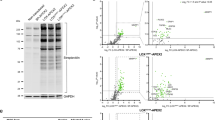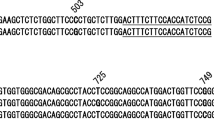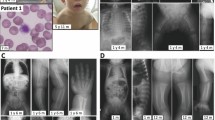Abstract
Congenital disorders of glycosylation (CDG) comprise a rapidly growing group of inherited disorders in which glycosylation of glycoproteins is defective due to mutations in genes required for the assembly of lipid-linked oligosaccharides, their transfer to nascent glycoproteins (CDG-I) or the processing of protein-bound glycans1,2 (CDG-II). Previously' a defect in the GDP-fucose import into the lumen of the Golgi was identified in a person with CDG (A.C.) with a general deficiency of fucosyl residues in glycoproteins3. This patient presents the clinical features of leukocyte adhesion deficiency type II (LAD II) including mental retardation, short stature, facial stigmata, and recurrent bacterial peripheral infections with persistently elevated peripheral leukocytes4,5,6,7. Using a fucose-specific, lectin-staining procedure for detection of fucosylated glycoproteins and a retroviral cDNA library, we isolated a cDNA complementing the fucosylation defect in the patient's fibroblasts. The cDNA encodes a highly hydrophobic protein of 364 amino acids with multiple putative transmembrane domains. Restoration of GDP-fucose import activity in Golgi-enriched vesicles from the patient's fibroblasts verified the GDP-fucose transporter activity of this protein. We identified two missense mutations in the GDP-fucose transporter cDNA of patient A.C. and of two other people with LAD II. Thus complementation cloning allowed us to identify the human GDP-fucose transporter cDNA and GDP-fucose transporter deficiency as a cause for a new type of CDG. Following the recent recommendations2,8 for the nomenclature for CDG, this new type is classified as CDG-IIc (formerly LAD II).
This is a preview of subscription content, access via your institution
Access options
Subscribe to this journal
Receive 12 print issues and online access
$209.00 per year
only $17.42 per issue
Buy this article
- Purchase on Springer Link
- Instant access to full article PDF
Prices may be subject to local taxes which are calculated during checkout





Similar content being viewed by others
References
Krasnewich, D. & Gahl, W.A. Carbohydrate-deficient glycoprotein syndrome. Adv. Pediatr. 44, 109–140 (1997).
Participants 'First International Workshop on CDGS'. Carbohydrate-deficient glycoprotein syndromes become congenital disorders of glycosylation: an updated nomenclature for CDG. Glycoconj. J. 16, 669–671 (1999).
Lübke, T., Marquardt, T., von Figura, K. & Körner, C. A new type of carbohydrate-deficient glycoprotein syndrome due to a decreased import of GDP-fucose into the Golgi. J. Biol. Chem. 274, 25986–25989 (1999).
Marquardt, T. et al. A new patient with leukocyte adhesion deficiency (LAD) II syndrome. J. Pediatr. 134, 681–688 (1999).
Frydman, M. et al. Rambam-Hasharon syndrome of psychomotor retardation, short stature, defective neutrophile mobility, and Bombay phenotype. Am. J. Med. Genet. 44, 297–302 (1992).
Etzioni, A. et al. Recurrent severe infections caused by a novel leukocyte adhesion deficiency. N. Engl. J. Med. 327, 1789–1792 (1992).
Etzioni, A., Gershoni-Baruch, R., Pollack, S. & Shehadeh, N. Leukocyte adhesion deficiency type II: long term follow-up. J. Allergy Clin. Immunol. 102, 323–324 (1998).
Participants First International Workshop on CDGS. Carbohydrate-deficient glycoprotein syndromes become congenital disorders of glycosylation: an updated nomenclature for CDG. Glycobiology 10, iii–vi (2000).
Miura, N. et al. Human UDP-galactose translocator: Molecular cloning of a complementary DNA that complements the genetic defect of a mutant cell line deficient in UDP-galactose translocator. J. Biochem. (Tokyo) 120, 236–241 (1996).
Lühn, K., Wild, M., Eckhardt, M., Gerardy-Schahn, R. & Vestweber, D. The gene defective in leukocyte adhesion deficiency II encodes a putative GDP-fucose transporter. Nature Genet. 28, 69–72 (2001).
Marquardt, T. et al. Correction of leukocyte adhesion deficiency type II with oral fucose. Blood 94, 3976–3985 (1999).
Maniatis, N.T., Fritsch, E.F. & Sambrook, J. Molecular Cloning: A Laboratory Manual (Cold Spring Harbour Laboratory Press, Cold Spring Harbor, 1989).
Hofmann, K. & Stoffel, W. TMbase—a database of membrane spanning protein segments. Biol. Chem. 347, 166 (1993).
Sonnhammer, E.L.L., von Heinje, G. & Krogh, A. A hidden Markov model for predicting transmembrane helices in protein sequences. Proc. Int. Conf. Intell. Syst. Mol. Biol. 6, 175–182 (1998).
Acknowledgements
We thank W. Knabe for help with photography and L. Sander for technical assistance. This work was supported by the Deutsche Forschungsgemeinschaft, the Graduiertenkolleg 60 and the Fonds der Chemischen Industrie.
Author information
Authors and Affiliations
Corresponding author
Rights and permissions
About this article
Cite this article
Lübke, T., Marquardt, T., Etzioni, A. et al. Complementation cloning identifies CDG-IIc, a new type of congenital disorders of glycosylation, as a GDP-fucose transporter deficiency. Nat Genet 28, 73–76 (2001). https://doi.org/10.1038/ng0501-73
Received:
Accepted:
Issue Date:
DOI: https://doi.org/10.1038/ng0501-73
This article is cited by
-
Shedding of N-acetylglucosaminyltransferase-V is regulated by maturity of cellular N-glycan
Communications Biology (2022)
-
Progress in Structural Biology of Solute Carriers
Current Molecular Biology Reports (2021)
-
Biallelic variants in SLC35C1 as a cause of isolated short stature with intellectual disability
Journal of Human Genetics (2020)
-
The physiological and pathological roles and applications of sialyl Lewis x, a common carbohydrate ligand of the three selectins
Glycoconjugate Journal (2020)



